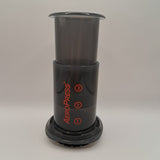The Magic of the Aeropress: A Coffee Lover's Must-Have
In the realm of coffee aficionados, there exists a tool that has garnered a cult-like following for its simplicity, versatility, and the exceptional brew it produces – the Aeropress. This unassuming device has earned a special place in the hearts of baristas and home brewers alike, redefining the way we perceive and experience coffee. Join us as we delve into the history, and mechanics of the Aeropress, along with a couple of tantalizing recipes to kick-start your coffee journey.
A Brief History
The story of the Aeropress dates back to 2005 when inventor Alan Adler, renowned for his invention of the Aerobie flying ring, introduced this innovative coffee maker to the world. Fueled by his dissatisfaction with the bitter, over-extracted taste of traditional brewing methods, Adler set out to create a device that could produce a smooth, rich cup of coffee in a matter of minutes.
Drawing inspiration from the principles of espresso brewing, Adler designed the Aeropress to combine immersion brewing with gentle pressure, resulting in a remarkably clean and flavorful cup. With its sleek design, affordability, and ease of use, the Aeropress quickly gained popularity among coffee enthusiasts, earning accolades and winning numerous awards for its outstanding performance.
The Mechanics of Aeropress

At first glance, the Aeropress may appear deceptively simple – a plastic tube with a plunger and a filter cap. However, its beauty lies in its elegant simplicity and the endless possibilities it offers for experimentation. Here's a quick rundown of how it works:
- Preparation: Start by placing a paper filter inside the filter cap and rinsing it with hot water to remove any paper taste. Attach the filter cap to the bottom of the Aeropress.
- Grind: Grind your coffee beans to a medium-fine consistency, similar to table salt.
- Brewing: Insert the plunger into the Aeropress chamber, creating a seal. Add ground coffee to the chamber, pour hot water (around 200°F or 93°C), and stir gently for a few seconds to ensure even saturation.
- Pressing: After allowing the coffee to steep for the desired duration (typically 1-2 minutes), place a mug or carafe on the bottom of the Aeropress and slowly press the plunger downwards. The gentle pressure forces the brewed coffee through the filter, extracting the flavors while leaving behind the grounds.
- Enjoy: Voila! Your perfectly brewed cup of coffee is ready to be savored. Adjust the strength and flavor by experimenting with grind size, water temperature, and steeping time to suit your preferences.
Two Irresistible Aeropress Recipes
- Classic Aeropress Brew
- Ingredients:
- 15g of freshly ground coffee (medium-fine)
- 200ml of water (just off the boil)
- Method:
- Rinse the paper filter and attach it to the Aeropress.
- Add the ground coffee to the chamber.
- Pour the hot water over the coffee grounds, stirring gently.
- Steep for 1 minute, then insert the plunger and press gently for 30 seconds.
- Dilute with hot water if desired and enjoy!
- Aeropress Iced Coffee
- Ingredients:
- 30g of freshly ground coffee (medium-coarse)
- 150ml of hot water
- Ice cubes
- 50ml of milk (optional)
- Sweetener of your choice (optional)
- Method:
- Prepare the Aeropress as usual with the rinsed filter and ground coffee.
- Pour the hot water over the coffee and stir gently.
- Allow the coffee to steep for 1-2 minutes.
- Press the coffee directly over a glass filled with ice cubes.
- Add milk and sweetener if desired, stir well, and enjoy a refreshing iced coffee delight!
In conclusion, the Aeropress stands as a testament to the ingenuity and passion of coffee lovers worldwide. Whether you're a seasoned barista or a casual coffee enthusiast, this remarkable device offers endless opportunities to explore and savor the nuances of your favorite beans.